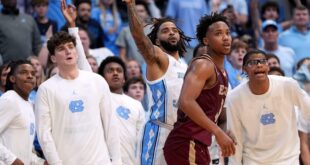Texas is back … at No. 1.
For the first time in nearly 16 years, the Longhorns are atop the Associated Press Top 25, surpassing Georgia when the latest poll was released on Sunday. That achievement has little tangible meaning now for the Longhorns; how they fare in their inaugural season of SEC play will determine how realistic their national championship expectations are. Still, it’s a landmark achievement for a program that has been through the wringer since its last appearance at No. 1 on Oct. 26, 2008.
Through the first three weeks of this season, Texas has been dominant. But there’s still a lot to learn about the 2024 Longhorns, who host Louisiana-Monroe in their nonconference finale on Saturday before their SEC schedule kicks off on Oct. 5.
And last Saturday, they got even more interesting, when starting quarterback Quinn Ewers went down with an oblique injury and Arch Manning came in to lead the rest of a blowout win against UTSA.
Let’s assess what we know — and what we don’t — about what is currently the best team in the land.
What we know
We can stop asking if Texas is back.
For years after ESPN play-by-play man Joe Tessitore declared, “Texas is back, folks!” when Tyrone Swoopes scored a game-winning touchdown against Notre Dame to open the 2016 season, the phrase was used as a punchline by opposing fans while the Longhorns spun their wheels.
Last year’s appearance in the College Football Playoff was Texas’ best season since 2009, and three games into this year, the undefeated Longhorns show no signs of slowing down. The roster is loaded, the coaching staff is stable and Texas’ recruiting is top notch. It’s still premature to say the Longhorns will repeat their 2001 to 2009 run, when they went 101-16. The new 16-team SEC will be a bear for years to come.
But the foundation is set and the pieces are in place for Texas to consistently be in the hunt for championships if the Longhorns can keep the machine running the way it is now.
The Longhorns are in great hands at QB.
Texas already had one of the best quarterbacks in the country in Quinn Ewers. He was playing better than he ever has in a Texas uniform before an oblique strain knocked him out of the Longhorns’ 56-7 win over UTSA on Saturday.
But all is well because the Longhorns also have Arch Manning.
The redshirt freshman with the famous last name has been the subject of intense curiosity ever since he emerged as a recruit, but before this season, he only had 27 college snaps to his name. His appearance in the season-opening 52-0 win over Colorado State included four series, 26 snaps and his first career touchdowns, but on Saturday, we got a real dose of what Manning looks like with the first team.
In just 29 snaps across two-plus quarters, he was magnificent. He threw four touchdown passes and showed off impressive speed on a 67-yard touchdown run. He operated the offense cleanly and efficiently, took care of the ball and didn’t commit major unforced errors.
Yes, it was an overmatched UTSA team that Manning faced, and no, it’s not always going to look as easy for him as it did on Saturday night. But so far, Manning’s skill set and command of the position is impressive. He looks plenty capable of leading the Longhorns for however long they need him to if Ewers is out for a game or two.
Don’t expect this to become a quarterback controversy while Ewers is sidelined. Ewers, who has three years of experience in this offense, is one of the team’s leaders and one of the best quarterbacks in the country. He, too, was once the No. 1 recruit in the country and is a potential first-round NFL Draft pick.
Manning is superbly skilled and talented but has only taken 82 college snaps. When Ewers returns from injury, he will still be QB1.

GO DEEPER
Arch Manning transferring from Texas never would have made sense
The new receivers are stellar.
One of the Longhorns’ biggest questions entering this season was how they would replenish their receiving corps after all three of their 2023 starters — Xavier Worthy, Adonai Mitchell and Jordan Whittington — were drafted. Texas coach Steve Sarkisian hit the portal and the recruiting trail to address those losses, adding transfers Isaiah Bond (Alabama), Matthew Golden (Houston) and Silas Bolden (Oregon State) and signing four high school receivers, headlined by five-star prospect Ryan Wingo.
Through three games, Bond and Golden have quickly established themselves as impact players. Bond leads the team with 13 catches for 215 yards; Golden is second on the team with 12 catches for 125 yards. Each have three touchdown catches, and Golden also serves as the primary kickoff returner.
Bolden has been a rotational receiver but has been a reliable punt returner, a role he starred in at Oregon State. The biggest revelation at the position has been Wingo, who has quickly become a big-play dynamo. Six of his seven receptions have been for 15 or more yards, including three for 30 or more yards. He also had a 55-yard run against Michigan on a reverse. Wingo is averaging 31.5 yards per touch.
“I don’t know that I’ve ever been around a guy, through three games, that has had the explosive play ability that he’s possessed,” Texas coach Steve Sarkisian told reporters on Monday. “He’ll tell you … he’s not a finished product. We’re still working on a lot of the details in his game, but he definitely has a very, very bright future.”
At tight end, the absence of Ja’Tavion Sanders, another NFL Draft pick, has also been smoothed over, but not with a transfer. Senior Gunnar Helm has emerged as a reliable pass catcher with 10 receptions for 189 yards.
So far, the passing game hasn’t missed a beat.
Texas’ depth is as advertised.
Coming into the season, Sarkisian said he wanted give snaps to as many players as possible early in the season — including first-half snaps — to help solidify depth for what he hopes is a title run deep into January. So far, that plan has played out as he hoped.
Through three games, no defensive player in the front seven has played more than 40 snaps in a single game, according to Pro Football Focus. Much of that is a function of the Longhorns gaining commanding leads, but even in the Michigan game, where Sarkisian shortened the rotation on both offense and defense, most of the defensive players played 40 snaps or fewer.
Texas went three-deep at most positions on defense against Colorado State and UTSA and in a handful of areas on offense in those two games. Even against Michigan, the Longhorns were able to get a solid helping of second-teamers in the game.
Sarkisian pointed out that against UTSA, 77 of Texas’ 120 players played, six players scored touchdowns, nine players carried the football and 11 caught a pass. On defense, 28 players recorded a defensive statistic.
They have a capable defense.
Losing key players like defensive linemen T’Vondre Sweat and Byron Murphy, linebacker Jaylan Ford and cornerback Ryan Watts to the draft left at least some doubt as to whether the Longhorns would be as stout defensively as they were in 2023, when they ranked third nationally in run defense and second in third down conversions. It’s not as dominant as it was then, but it’s still a solid unit: The 2024 Longhorns rank 11th in third down defense and 44th in run defense.
And in the most important area — points allowed — Texas has excelled. The Longhorns have allowed just 6.3 points per game.
“We tackle really, really well,” Sarkisian said. “We’re attacking the football right now. Defensively, we’re creating turnovers and they’re having a lot of fun.”
They’re much better in the red zone.
Last season, red zone offense was one of the Longhorns’ biggest weaknesses. They ranked 120th nationally in red zone touchdown rate, finding the end zone on just 50.8 percent of trips inside the 20. This year, they’ve completely reversed the trend, ranking seventh nationally by scoring touchdowns on 14 of their 16 red zone trips. Sarkisian attributed the improvement to his team’s discipline, minimizing self-inflected errors in that part of the field, as well as simplifying his red zone call sheet to focus on a smaller set of plays that Texas has feverishly repped.
What we don’t know
How will Texas hold up in the SEC?
So far, everything points to the Longhorns being an SEC title contender. The Longhorns are big in the trenches, fast on the perimeter and deep at key positions thanks to the roster Sarkisian and his staff have built since his first year at Texas. But it’s one thing to prepare for the grind of an SEC schedule and another to endure it. Will the run defense hold up every week? Can Texas win its clunkers in conference play the way it did in its final Big 12 campaign, particularly against Houston and Kansas State? The Longhorns will need the mental discipline to get up for every opponent.
Can the Longhorns play from behind?
The Longhorns have not trailed in a game all season. Over 180 minutes of game action, Texas has only been tied for 21 minutes and 43 seconds, according to TruMedia. The Longhorns have led the rest of the time they’ve been on the field. How will they respond when they are in a hole, particularly in the second half?
How good is the run defense?
Last season, Texas was elite at stopping the run, allowing just 2.9 yards per rush and 82.4 rush yards per game. This year, opponents have found more room to run, averaging 3.5 yards per rush and 108.7 rush yards per game. It’s not as though the floodgates have opened. Texas is still in the top half of Power 4 teams in run defense, and the Longhorns held the one ranked opponent they faced, run-heavy Michigan, to just 80 rushing yards. But it will be worth watching how the Longhorns fare when they face higher-caliber opponents who try to run right at them.
Can the running backs hold up?
Texas has had significant hits to the running back depth chart this season.
The Longhorns lost starting running back CJ Baxter and true freshman Christian Clark to season-ending injuries in training camp. Jaydon Blue was next up as the starter and has performed well when available, but he missed the UTSA game.
Sophomore Tre Wisner has been solid, and Gibson has been an encouraging option as a true freshman. Getting Blue back to full health will provide a boost. The longer Texas can keep the trio of Blue, Wisner and Gibson healthy, the better.
Beyond those three, Sarkisian moved receiver Ryan Niblett to running back and has also given carries to walk-on Colin Page and transfer Velton Gardner, a former SMU running back that Texas pulled from the portal in August after the Baxter and Clark injuries.
How will they fare in crunch time?
In each of their first three games, the Longhorns entered the fourth quarter leading by at least three touchdowns. As they enter SEC play, those margins won’t always be so wide, and their mettle will be tested. Texas’ mid-October two-step against Oklahoma and Georgia figures to be first true challenge on the schedule.
(Photo: Tim Warner / Getty Images)
Source link
 meganwoolsey Home
meganwoolsey Home



